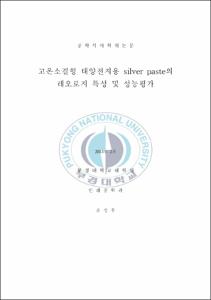고온소결형 태양전지용 silver paste의 레오로지 특성 및 성능평가
- Abstract
- A study on Silver paste for solar cell performance evaluation and rheological measurements
Jung-Woo Cho
Department of Graphic Arts Engineering, Graduate School,
Pukyong National University
Abstract
The sun is a limitless and clean source of power. The energy the earth's surface receives from the sun in one hour is equivalent to the world's annual energy consumption and almost none of the greenhouse gas associated with fossil fuels is produced from solar power. Solar power generation is the technique of obtaining electricity directly from sunlight, at the core of which lie solar cells, which convert sunlight directly into electricity.
Early solar cells were used to generate power on spacecraft and their application to regular power generation began to receive attention after the oil shocks of the 1970s. As energy and environmental issues become global problems, solar cells have come to be considered as one of the most viable renewable energy technologies.
Solar cell production has increased by more than 40 percent each year for the past five years and in 2007 more than 4 gigawatts worth were produced and production is projected to reach 20 gigawatts worth in 2010. If the current growth rate is maintained, electricity from photovoltaics (PV) will be able to supply 10 percent of the world's total electricity needs.
At present, first generation solar cells - those made from crystalline silicon - account for about 90 percent of the market. However, problems with silicon supplies and conversion efficiency and the high production cost have prevented solar cells from being economically competitive and hampered the growth of the solar power industry.
So, in order to overcome the limitations of the first generation solar cells and produce them more cheaply, research organizations and companies all over the world are trying to develop next generation of solar cells through technologies like amorphous silicone, GaAs, CIGS, CdTe, spherical silicone solar cell.
Spherical silicone solar cells are produced from silicon ball and aluminium sheets. Since they are more inexpensive than crystalline silicon wafers and they can be produced using only about 20 percent of the materials required for crystalline silicon wafer production. As such, the production cost is expected to be dramatically lower with Spherical silicone solar cells.
This study shows a method manufacturing a front electrode for spherical silicone solar cell by the screen print method and contents that the physical properties examined.
Flake type, Spherical type, Aggregation type's Ag powder was used as a conductivity filler and made comparitive pastes on Ethyl Cellulose resins as an organic binder to give adhesive strength on substrate.
The purpose of this study is to know the effects of the conductivity filler on Ag paste including dispersibility, conductivity and adhesive property and a special quality of the solar cell including Jsc, Fill factor, Voc, Rseise and Efficiency.
- Issued Date
- 2013
- Awarded Date
- 2013. 2
- Type
- Dissertation
- Publisher
- 부경대학교
- Affiliation
- 부경대학교 대학원
- Department
- 대학원 인쇄공학과
- Advisor
- 남수용
- Table Of Contents
- Ⅰ. 서 론 1
Ⅱ. 이 론 3
1. 태양 전지(Solar cell) 3
가. 태양전지의 기본 구조 3
나. 전지 동작 원리 4
다. 태양전지 성능평가 파라메타 4
2. 스크린 인쇄의 원리 6
가. 스크린인쇄 제판기술 7
나. 스크린인쇄시 인쇄파라메타에 따른 인쇄 품질 9
3. 고온소결형 Ag Paste 제조기술 11
가. Paste의 기본 설계 13
4. 레올로지 15
가. 레오로지의 S-S곡선 15
나. 동적점탄성 18
다.스크린인쇄시 Paste의 거동 22
Ⅲ. 실 험 23
1.태양전지 전극용 시약 및 페이스트 제조 23
가. 태양전지 전극용 시약 23
(1) 전도성 필러 23
(2) 바인더 25
나. Ag 페이스트 제조 26
다. 스크린 인쇄 27
2. 측정 및 분석 28
가. Ag 페이스트의 분산 특성 측정 28
나. Ag 페이스트의 레올로지 특성 측정 28
다. 전도성패턴의 전기전도성 측정 29
라. 전도성 패턴의 형상 측정 29
마. 태양전지의 성능 측정 29
Ⅳ. 결과 및 고찰 30
1. Ag 종류에 따른 Ag 페이스트의 분산성 30
2. Ag 종류에 따른 Ag 페이스트의 레올로지 특성 31
3. Ag 종류에 따른 전극 패턴의 형상 34
4. Ag 종류에 따른 Ag 페이스트의 전기전도성 38
5. 태양전지의 광전변환효율 특성 38
가. 태양전지 제조 공정 38
(1) 표면 조직화 공정 38
(2) 에미터 형성 공정 39
(3) Phousporus Silicate Glass 제거 39
(4) 반사방지막 형성 39
(5) 전극 형성 공정 39
나. 태양전지 성능 특성 평가 44
Ⅴ. 부 록 46
1. D사 Paste 분석 46
Ⅵ. 결 론 48
참고문헌 50
- Degree
- Master
- Files in This Item:
-
-
Download
 고온소결형 태양전지용 silver paste의 레오로지 특성 및 성능평가.pdf
기타 데이터 / 4.09 MB / Adobe PDF
고온소결형 태양전지용 silver paste의 레오로지 특성 및 성능평가.pdf
기타 데이터 / 4.09 MB / Adobe PDF
-
Items in Repository are protected by copyright, with all rights reserved, unless otherwise indicated.